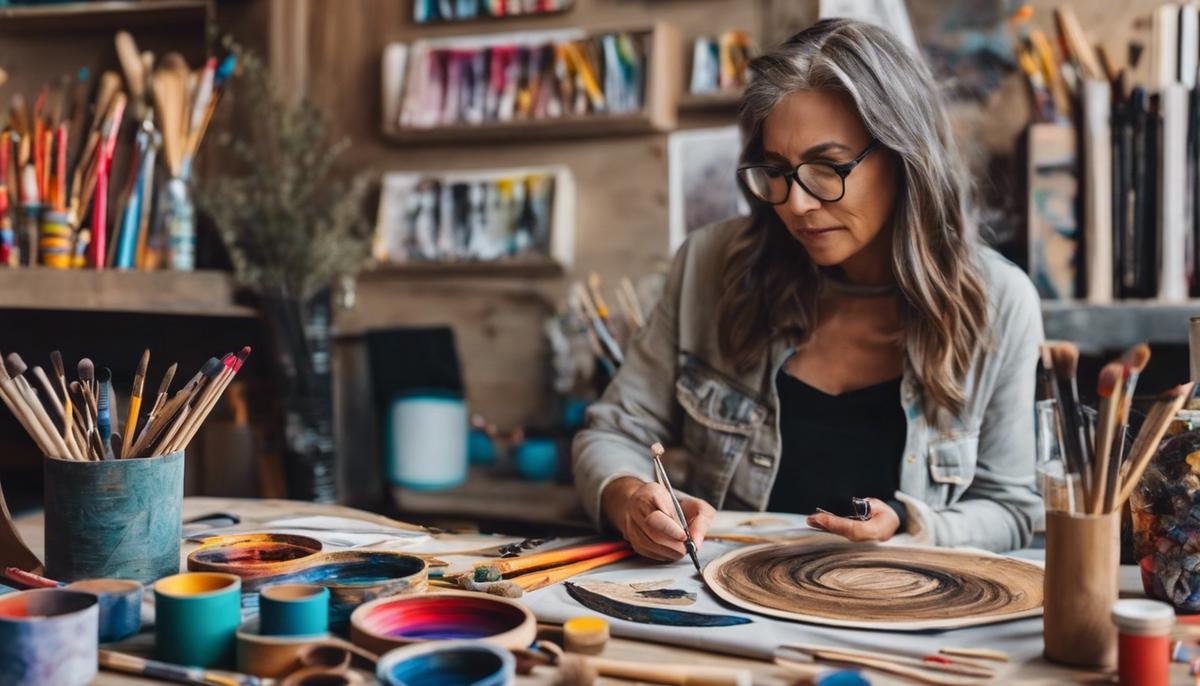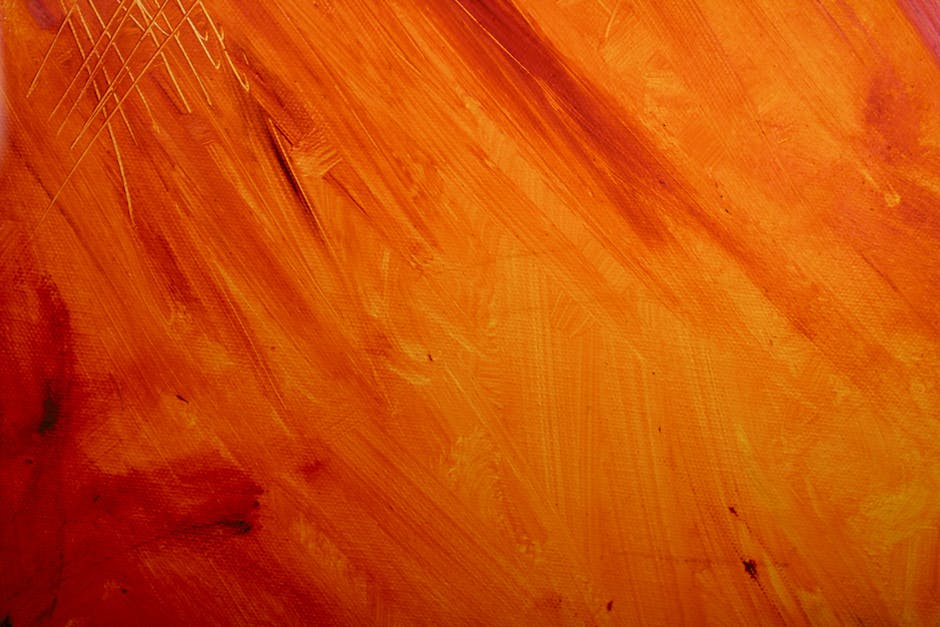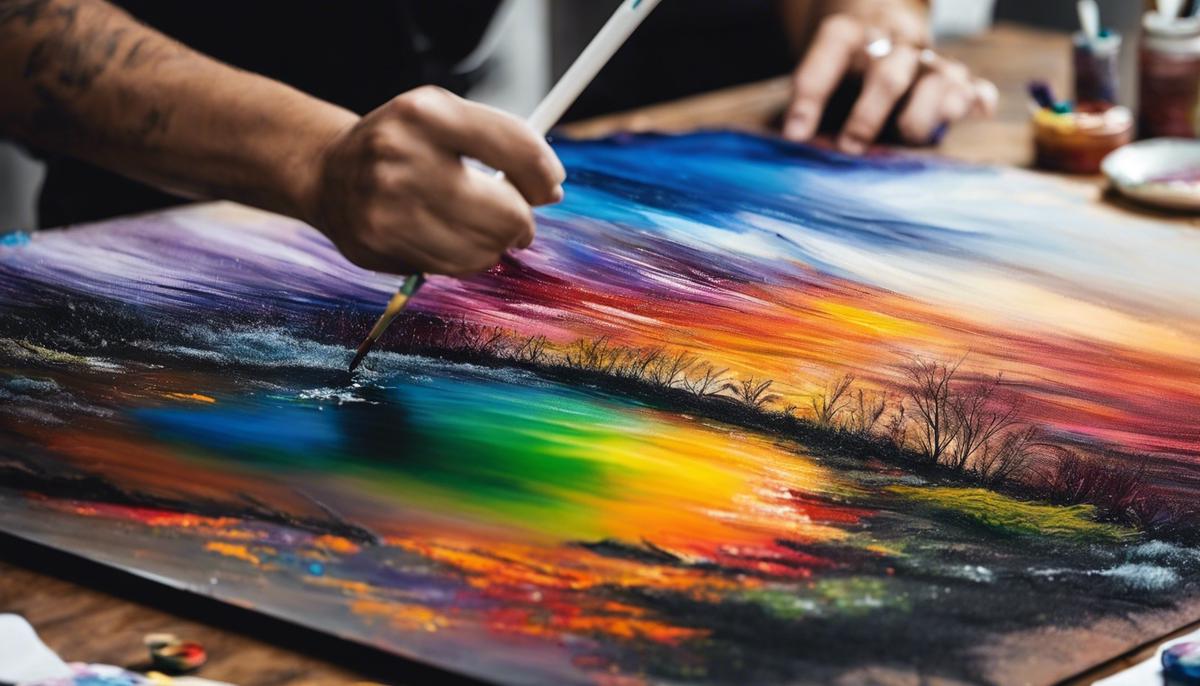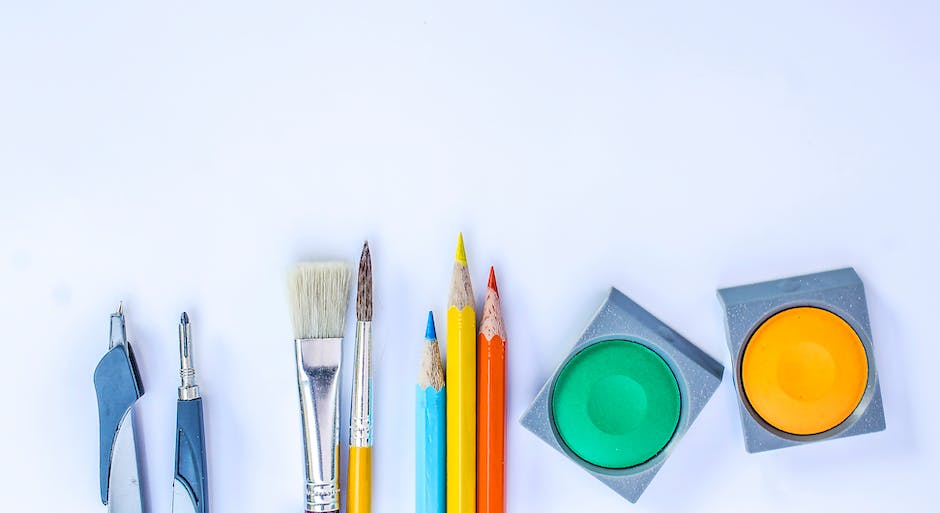The intertwining principles of art therapy and psychology offer a compelling avenue for understanding and addressing an array of psychological challenges. This exploration commences with a detailed dissection of the historical background and principles of art therapy, in an attempt to clearly trace its roots and define its foundation. By unveiling the psychological theories and evidence supporting this form of therapy, a deliberate distinction is made between art therapy and other psychotherapies. Indeed, art therapy is not just another psychotherapy, but rather, a unique approach that interacts intricately with psychological principles. Consequently, the conversation will further delve into how art therapy facilitates psychological healing, reflecting upon the neurological principles and creative aspects that undergird this therapeutic process.
Art Therapy: Background and Principles
Entitled: “Understanding Art Therapy and its Fundamental Guiding Principles”
Art therapy emerges as a quintessential element of therapeutic practice, thoroughly steeped in the intriguing confluence of creativity, psychology and healing. From its advent in the mid-20th century, art therapy has evolved as a formal profession, leveraging the power of art-making within a framework of therapeutic principles.
At its root, art therapy reflects a modality of mental health treatment which facilitates expressive creation as a vehicle for healing. It relies on the premise that the process of creating artefacts holds significant therapeutic value, especially when combined with the guidance provided by a qualified art therapist. Grappling with diverse issues ranging from anxiety and depression to traumatic experiences, the engagement with artistic medium provides an alternative pathway for expressing and confronting these psychological complexities.
Existing research emphasises the efficacy of art therapy for a diverse range of demographic profiles, including children, adolescents, adults and the elderly. However, it is prudent to ensure the scope of the practice is thoroughly considered, as the benefits significantly correlate with the appropriateness of the method to the client’s individual needs and unique circumstances.
Core guiding principles underlie the practice of art therapy, cementing its function and feeding its efficacy. Art therapy’s primary commitment is to the therapeutic alliance, heightening sensitivity to the unique needs, perceptions, and experiences of each client. Integral to this commitment is a respect for the client’s autonomy, mirroring a central tenet of other therapeutic fields.
The art-making process itself acts as a symbolic and non-verbal repository of the client’s inner world, fostering restoration, integration and healing. The therapist’s role is not to interpret or critique the art, but to facilitate the client’s engagement with the creative process, as well as their subjective interpretation of their artwork.
Another cardinal principle of art therapy is its holistic approach, which represents the whole person – mental, emotional, physical and even spiritual aspects are considered within the therapeutic framework.
In the end, art therapy offers a resonant testament to the transformative power of creativity, melding the worlds of art and psychology to propel positive change and healing. Erected atop its central guiding principles, it stands as an innovative custom tailored therapeutic strategy, carving out its unique path in the broader field of mental health is art therapy.

Art Therapy’s Role in Psychological Healing
Harnessing Art Therapy for Post-Traumatic Stress Disorder
Art therapy as a modality of treatment transcends the realm of traditional psychotherapy, holding promise for individuals grappling with Post-Traumatic Stress Disorder (PTSD). PTSD, a psychological disorder that occurs following traumatic events, is often marked by a series of complex symptoms such as flashbacks, debilitating anxiety, and persistent fear.
The intriguing aspect about art therapy is its capability to evoke cognitive processing through creative expressions. Artwork illuminates the non-verbal mind’s narrative, an area largely overlooked by verbal-based therapies. Studies demonstrate that traumatic memories are predominantly stored in the non-verbal and non-conscious part of the brain. Hence, it is plausible that methods which tap into this segment might yield promising therapeutic outcomes for PTSD sufferers.
Art therapy’s role is two-fold for PTSD patients; it not only offers a constructive outlet for emotions but also aids in the reformation of these traumatic memories. Veterans, for instance, who have experienced gruelling situations of mortal combat often struggle with verbalising their traumatic episodes. By engaging in art therapy, they can organise and externalise these experiences via tangible artwork – an expressive conduit to process and manage PTSD symptoms effectively.
A cornerstone of this therapeutic modality is ‘Trauma-Informed Art Therapy’. This specific approach integrates neuroscience, trauma theory, and attachment theory while being sensitive to the safety and the pacing of therapy. It provides an embodied therapeutic encounter, acknowledging that trauma often resides in the body. Creating kinaesthetic art, in turn, can help lessen the external signs of PTSD by focusing on sensory integration and bolstering resilience.
Art therapy further capitalises on the ‘mastery experience’– a concept within Bandura’s self-efficacy theory. This theory postulates that individuals possessing a high sense of self-efficacy are more likely to take on challenging tasks and remain committed to them despite obstacles. By successfully executing an art task, PTSD sufferers cultivate a sense of self-efficacy, fostering a positive perception about themselves and their capabilities.
Finally, art therapy is being employed in ‘Exposure Therapies’, where patients face and re-live their triggering event in a controlled environment to reduce fear responses. Here, art is used as a transitional object which aids patients to narrate traumatic episodes with fewer fears of being overwhelmed. This is due to the transformative property of art, which enables expressions without compelling the individual to directly confront the trauma.
In conclusion, art therapy proves itself an adventurous foray into the domain of PTSD treatments. By leveraging its unique healing advantages, art therapy might soon cement its position as an essential tool within the repertoire of PTSD treatment strategies, guiding many on the treacherous path towards healing and rejuvenation.

Art Therapy Techniques: Psychological Connections
Diving into the tapestry of art therapy techniques and psychological healing processes, one can explore a broad range of exciting intersections including trauma-informed art therapy, application of storytelling through art in PTSD treatment, and the theory of kinaesthetic recovery.
Art therapy brings a unique perspective in addressing post-traumatic stress disorder (PTSD), a mental health condition that’s triggered by a terrifying event. Incorporating art therapy techniques can offer therapeutic benefits by retraining cognitive processes that may be impaired due to severe trauma.
Imagery is frequently more salient in traumatic memories making art therapy an effective method for expressing and processing such experiences. Drawing on neuroscience, trauma theory, and attachment theory, Trauma-Informed Art Therapy acknowledges the profound effects of trauma on the brain, behaviour, and relationships, offering a novel way to process trauma and restore wellbeing.
Kinaesthetic art therapy, another technique, harnesses physical movement and sensation as a fundamental aspect of the art-making process. This focus on sensory integration can bolster resilience, especially in PTSD patients struggling with sensory dysregulation following trauma. Through manipulating art materials, they gain an increased sense of control and safety.
Storytelling through art also plays a significant role when working with people suffering from PTSD. Art provides a way to tell one’s story without the necessity of verbalisation, functioning as a non-threatening medium to expose and understand traumatic events. This technique aligns with the principles of exposure therapies used in psychotherapy, where the response to feared stimuli is reduced through a process of desensitisation.
The creation of art in a supportive, therapeutic environment may also furnish the individual with a ‘mastery experience’. This concept explains how art therapy can cultivate a sense of self-efficacy, impacting an individual’s belief in their ability to accomplish tasks and face challenges, which in turn can increase self-esteem and self-confidence, key elements in PTSD recovery.
From engaging in the physicality of art-making to documenting their traumatic experiences and progress, art therapy provides PTSD patients with an assortment of therapeutic tools. It serves as a lens through which the therapeutic relationship, cognitive processes, and overall healing journey can be viewed, underscoring the boundless possibilities that lie in the nexus of art and psychology. Furthermore, it continues to reshape scientific understanding of PTSD treatment strategies and paves the way for novel interdisciplinary approaches.
By integrating art therapy techniques within a comprehensive treatment strategy, we not only cast light on innovative roads to recovery but make an essential contribution to this evolving field of mental health, confirming the value of bridging academia, creative expression and healing in pursuit of transformative mental health interventions.

Research and Case Studies in Art Therapy
Art Therapy and Psychological Healing: An Overview of Efficacy
Delving deeper than the mere application of art as a therapeutic medium, let us explore the tangible benefits drawn from extensive research and compelling case studies that underline the potency of art therapy in the domain of mental health treatment.
Art therapy is not just about the process but extends to outcomes, too, with various scientific studies demonstrating significant positive outcomes in clients who’ve engaged with this modality. Studies show a marked decrease in distress symptoms across a variety of mental health conditions, with prominent efficacy in addressing anxiety and depressive disorders.
As such, this may be attributed to art therapy’s distinctive approach of non-verbal expression, where clients interpret their emotions and cognitions into visual narratives. This bypass of verbal barriers offers the potential for deeper insight and understanding of the individual’s psyche, making it an effective tool in addressing complex psychological issues.
There is a growing body of evidence supporting the application of art therapy among individuals with Post-Traumatic Stress Disorder (PTSD). As an intricately designed therapeutic strategy, art therapy can trigger cognitive processing in a non-threatening manner, providing a safe space for the exploration and processing of traumatic experiences. This outlet helps reformulate traumatic memories, fostering forward progression and growth.
Strategically employed, Trauma-Informed Art Therapy combines neuroscience, trauma theory, and attachment theory. It allows the unlocking of cognitive pathways obstructed by trauma, moving beyond the words that trauma victims often find lacking. The amalgamation of these concepts, as seen in kinaesthetic art, offers a focus on sensory integration – a vital contribution to fostering resilience among PTSD sufferers.
A powerful concept underlying these therapies is ‘mastery experience’. Mastery in art therapy fosters a sense of accomplishment, bolstering self-efficacy in individuals and offering profound psychological benefits. The creation of an art piece is a tangible representation of the individual’s ability to influence their environment positively. This positively impacts their perception of their own abilities, underlining the importance of art therapy in PTSD healing processes.
The use of art within exposure therapies has seen productive outcomes too. Exposure therapy, traditionally a challenging treatment modality, has seen increased efficacy when paired with art therapy. The process of creating can serve as an emotional buffer, reducing extreme fear responses often experienced during trauma narrative exploration. Consequently, this can lead to increased resilience, marking a significant step towards healing.
The art therapeutic process can be integrated into wider strategies of PTSD treatment; its potential is immense. The approach can complement various treatment modalities including Cognitive Behavioural Therapy (CBT) and Eye Movement Desensitization and Reprocessing (EMDR). Given these benefits, it becomes increasingly clear that the use of art therapy exhibits a measurable ideology of efficacy that can be actualized in broader healing strategies.
It could be said that the elucidation of art therapy’s efficacy is an ever-evolving picture, much like the art it involves. As research progresses, so too does the understanding and appreciation of this poignant medium within the world of psychology and therapeutic healing. With every stroke on the canvas, a step is taken on the road to recovery – underlining the power of art therapy within psychological healing.

Future Directions for Art Therapy and Psychology
The Epistemological Evolution: Art Therapy Provisioning Pioneering Path
Varying perspectives on contemporary trends in both psychology and art therapy suggest the potential for rapid advancements in the near to distant future. Statistics cumulate an ever-growing pool of empirical data warranting an integrated understanding due to the consistent progression in both areas. As we observe the innovative integration of technology into both fields, we see the emergence of a new realm of possibilities with prospective implications for the enhancement of therapeutic interventions and reinforcement of quantifiable achievements in art therapy.
Advancements in psychology, stemming from enhanced neuroimaging techniques, have paved the way for more precise comprehension of the brain’s response to art. The incorporation of functional magnetic resonance imaging (fMRI) in psychological studies provide new insights into neuronal networks prompting cognitive and emotional responses to art. With art therapy’s elemental dependence on the stimulation of these neural circuits, the introduction of such developments could dramatically transfer the subtleties related to the application and evaluation of art therapy.
Further, cutting-edge research in neuroplasticity, or the brain’s ability to change throughout an individual’s life, opens promising doors for unprecedented healing through art therapy. With this emergent understanding, an art therapist can invigorate positive brain changes by guiding a client along creative pathways most beneficial for their unique neuroplastic potential.
Significant evolution has also been seen within the art therapy discipline itself. The digitisation age has seen art therapy incorporating the technological surge into its methodological array. Virtual reality (VR), in particular, has started emerging as a powerful tool in therapeutic regimes allowing for multi-sensory emersion with promising results in anxiety disorders, while applications such as digital painting or augmented reality offer novel avenues for self-expression and conceptualisation.
In addition, the widespread adoption of the telemedicine model, driven by the recent global pandemic, is reshaping the reach and accessibility of art therapy. Online platforms, initially a contingency plan, are increasingly demonstrating their efficacy as a primary therapeutic medium.
Yet, it’s the relentless spirit of innovation and flexibility within art therapists that ensures a continually evolving practice, dexterously embracing an array of new technologies and techniques to deliver an extensive scope of beneficial outcomes to patients.
Exciting advancements in both psychology and art therapy provide considerable scope for the advancement in the effectiveness of art therapy in psychological treatments. Through the amalgamation of both fields’ notable innovations, art therapy remains positioned to evolve continually, profoundly paving the way for strengthening its role in mental health treatment.
Undoubtedly, the synthesis of technology and understanding human cognition will allow for novel therapeutic strategies, enhancing the already transformative potential of art therapy. Ubiquitous digitization and torrential innovative ideas circulating through the global community imply a future teeming with potential for art therapy. These revolutionary developments poised at the therapeutic horizon make it an exciting era in the journey of psychology and art therapy alike.
‘As science sparks the art, art illuminates the science’ could indeed be the motto to anticipate the advent of a new dawn, a dawn where art plays the healing note, and psychology choreographs the recuperating rhythm.
Figuring it succinctly, as the line blurs between art therapy and psychology, the future seems brighter for individuals navigating their path through the labyrinth of mental or emotional turmoil. With this promising amalgamation, it seems only a handful of sunrises away that humanity spurs into an era where art therapy has revolutionized the approach towards mental health. Embracing this paradigm shift with hope and optimism, the future of art therapy in psychology hints towards infinite possibilities of triumphing over challenges.

While exploring the past and present landscapes of art therapy, this discussion also looks ahead to the future prospects of art therapy and psychology, outlining anticipated transformations and potential challenges. In this respect, a highlight of the current innovative practices emerging within the field as well as an exploration of future research trends are delved into. Considering the evidence presented from diverse case studies and empirical research, it becomes clear that art therapy holds a unique and important position within psychological practice, facilitating healing in ways that bring together the inherent human capacity for artistic creativity with profound psychological principles. Therefore, the advancement of this field heralds exciting implications not only for art therapy, but also for the wider landscape of psychology.

























